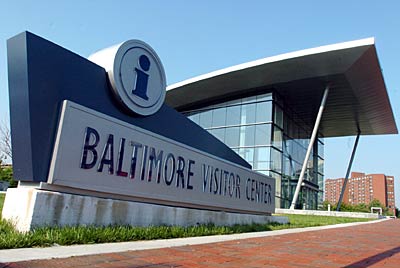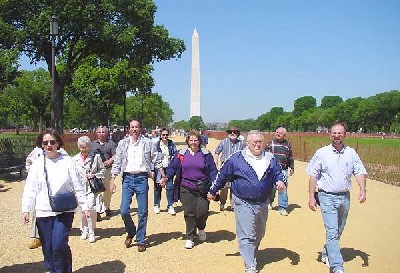Baltimore City Visitor Center has enviable financial return
 The Baltimore Visitor Center opened in May 2004 next to the Light Street Pavilion. (Baltimore Sun photo by Algerina Perna) May 11, 2004
The Baltimore Visitor Center opened in May 2004 next to the Light Street Pavilion. (Baltimore Sun photo by Algerina Perna) May 11, 2004I've written about the Baltimore Visitor Center in the past. I think it's a good model for what ought to be done in DC. I think that Library, Local History Museum, and Visitor Center functions can be coordinated in the planning for a new Central Library. See previous blog entries:
-- Who ♥ DC? -- More about DC tourism; and
-- Central Library Planning efforts and the City Museum, how about some learning from Augusta, Maine ... and Baltimore?).
However, I think it's important for DC recognize that it should focus tourism planning and marketing efforts in two very different ways. One centers upon the national story around the federal government and DC as the nation's capital. In many respects, this story sells itself, although it is important that DC be purposive in maximizing the benefits (such as my writings about having the National Mall Museums open til 9 pm, other use of the IMAX theaters there, etc.) and reducing the negative impacts from this tourism thread.
 Tourists determindely taking in the national experience.
Tourists determindely taking in the national experience.These tourists come to DC for the U.S. Capitol, the National Mall including the monuments and the Smithsonian Museums, the White House, Arlington Cemetary, trips to Alexandria and Georgetown for a dose of shopping along with some history, and now possibly a trip out to the Udvar-Hazy Air and Space Museum Annex out by Dulles Airport.
It's unlikely that these visitors can be enticed to stay an extra day or two (it takes awhile to get through that list of attractions as it is) to partake of the local history experience in addition, especially if this is their first visit to this fine city.
The other tourism effort centers around local history and architecture. And it is an interesting and important story (at least to me--ranging from Civil Rights, the development of urban neighborhoods, transit, immigration and ethnic groups building the city, historic preservation, etc.), but it is a difficult and harder sell compared to the national story. As I have said many times, this is a unique difficulty that DC has compared to other communities touting the benefits of "civic tourism."
That is why the general rostrums that cultural heritage tourists spend more money and time compared to "regular" tourists are harder to apply to DC, because the typical cultural tourist comes to DC to consume the "national" story rather than the more typical locally-oriented story offered most everyplace else.
This article from the Baltimore Business Journal, "Study: City visitor center boosts local tourism spending," reports on a market study of the impact of the Baltimore center, which is an estimated $3.5 million/annually. From the article:
The School of Tourism and Hospitality Management at Temple University in Philadelphia conducted the study on behalf of the Baltimore Area Convention and Visitors Association, the city's tourism agency. Temple officials surveyed 674 residents and out-of-towners to determine the impact that the Visitor Center has on their consumption habits. The survey was conducted between July 2004 and June 2005. The Visitor Center, located at the Inner Harbor, opened in May 2004 at a cost of $4.5 million.
More than one-quarter of local residents said they spent $107 more per day than originally planned after receiving information and services at the Baltimore Visitor Center. Out-of-town guests spent an additional $132 per day. Half of the Visitor Center's attendees were from Maryland, Pennsylvania, New Jersey, New York and Virginia.
Other key findings of the survey include:
-- Information on attractions (68 percent) was the most popular type of travel information sought, followed by entertainment and recreation (53 percent) and dining (53 percent).
-- Slightly more than two-thirds of survey respondents said they would visit attractions for the first time after stopping at the Visitor Center.
-- International visitors accounted for 7.6 percent of Visitor Center traffic.
-- About two-thirds of guests were 45 years of age or older.
-- Almost half of guests reported annual household incomes of $75,000 or more.
___________
Speaking of the national U.S. story shaping how people think about cultural heritage and Washington, DC, as a way of illustration, check out this article from Raleigh, "Nation's capital offers full slate during Memorial Day."
Index Keywords: tourism; arts-culture; museums



0 Comments:
Post a Comment
<< Home